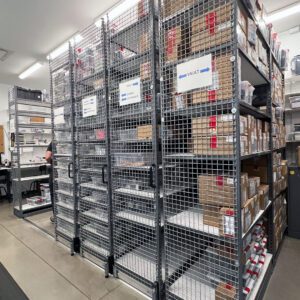Dispensary Inventory Management: Working With Limited Storage

How To Manage Inventory in a Dispensary With Limited Space

Balancing the supply and demand of cannabis is a complicated task. On one hand, in many newer U.S. markets, the product essentially sells itself. Flower tends to move fast, and the early days of a business are spent mainly on simply keeping up with customers’ needs. Even in more mature markets, like California or Colorado, demand remains high as prices have fallen through the floor.
But then there’s the matter of supply: Oversupply can contribute to backed-up inventory in the retail environment. In other cases, limited supply of a particular SKU or genetic profile can push dispensaries into a tight corner.
What’s a dispensary manager to do?
We covered some of the biggest dispensary inventory management mistakes (and solutions) that your team may face behind the counter. Basic organization of your inventory may sound like a no-brainer, but it’s not always so simple. Your team may encounter difficulty in tracking product availability and technical issues with sales reporting–and thus decreased customer satisfaction the longer that those problems linger.
Let’s zoom into these problems.
Consider the First In, First Out (FIFO) solution.
Timely Inventory Movement
First In, First Out

This approach is beneficial when considering overall dispensary inventory management–and easily overlooked, given the uncertain nature of supply and demand curves.
Product freshness is crucial, so you don’t want your oldest products to get bumped by newer products, inadvertently leaving you with even older products for the next customer.
Implementing FIFO ensures that older stock is sold before newer deliveries, reducing the chances of selling outdated or degraded products. Furthermore, FIFO aids in efficient stock rotation, minimizing waste and ensuring a consistent quality of the product offering to customers.
This is perhaps most important with flower, which can degrade in potency and flavor over time. Depending on your market regulations, flower may be kept in airtight jars with humidity control packs or it may be prepackaged in separate containers from the wholesaler. Either way, freshness is paramount, so a solid FIFO structure is critical to keep up with consumer demand.
READ MORE: Dispensary Storage: What You NEED to Know
But the same idea goes for concentrates and edibles and other products. Keep your concentrates stable by storing them in a cooler environment while adhering to the FIFO concept. Edibles should be moving through your inventory management system swiftly, as you don’t want to run up against expiration dates before you can sell what you’ve got.
Pro Tip: Set up automatic reordering thresholds within your inventory management system. When stock levels of a particular product fall below a predefined threshold, the system should automatically generate a purchase order and send it to the supplier. This threshold should be carefully calculated based on historical sales data, lead times, and current market trends to ensure products are reordered just in time before stockouts occur.
Just In Time

The JIT approach insists that your team orders stock as close as possible to when it’s actually needed. This reduces the amount of inventory that needs to be stored on-site, freeing up space and reducing the risk of overstocking or product expiration.
Unless your team specifically sought a property that was larger than needed at first (and thus designed for growth), at some point you will run up against a space problem. JIT inventory management may help solve that.
To achieve a JIT system, you’ve got to be able to rely on your suppliers. Again, this is no small task in markets wracked with a volatile supply curve. But establishing clear communication with growers and wholesalers in your market will ensure that you can acquire products quickly and move them through your storage racks with ease.
If you’re already working with that FIFO framework, your racks should be clearly labeled and organized. As new inventory comes in, just in the nick of time, your team should understand right away where it belongs in the stock room.
Related to the JIT concept, consider the strengths of a retail business that focuses on a curated selection of products that meet the preferences and demands of your customer base. Analyzing sales data and customer feedback can help identify high-turnover and high-margin products, allowing dispensaries to work efficiently even when space is limited. No need to invest in low-demand products on a JIT basis; both of these strategies assume that your team is engaged with your customer base and broader market trends.
Secured Storage Is Key
While FIFO addresses the organization and rotation of inventory and JIT acknowledges your literal space constraints, secured storage ensures the physical safety of your team and the compliance of the stored products.
Begin with your storage racks and zoom out: Consider all the ways you can optimize your space. By taking a holistic approach to secured storage, dispensaries can safeguard their operations and, inevitably, build trust with customers.
Secured storage systems protect inventory from theft, contamination, or degradation–crucial in maintaining product integrity and compliance with regulatory standards. Incorporating technology solutions like advanced locking mechanisms, surveillance systems, and inventory tracking software (even beyond what is mandated by your regulators) can enhance your secured storage space, ensuring that FIFO and JIT are implemented efficiently.
Conducting regular audits (biweekly or even weekly) of the secured storage area will ensure that all products are accounted for and that the dispensary inventory management systems are functioning as intended. Use those audits as a chance for the staff to re-familiarize themselves with the range of products and brands offered at your store.
Disorganized inventory can lead to numerous operational challenges, impacting customer satisfaction and regulatory compliance. Implementing a systematic approach to inventory management while keeping an eye on the actual supply and demand trends you’re facing is the ultimate goal.



